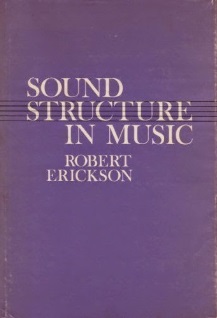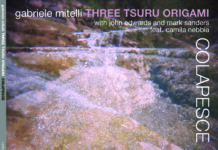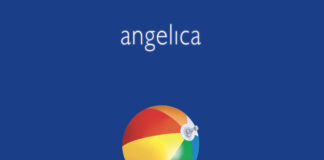Uno dei tratti distintivi della musica colta del XX secolo è l’emergere del timbro come oggetto di interesse musicale a sé stante, del tutto indipendente dal tono, armonia o ritmo. Il “classico” di Robert Erickson è un lavoro fondamentale per la comprensione di come il timbro funziona nella moderna musica d’arte. Pubblicato nel 1975, il libro rimane fondamentale per le sue intuizioni sui fattori orchestrali, strumentali, e anche in quelli fenomenologici, che entrano in gioco nella composizione dei suoni. Nello sviluppo del libro, Erickson ridefinisce e riscrive timbro,intonazione e accordi, alla luce delle pratiche di composizione e di performance contemporanee, e affronta i modi e i mezzi con cui i compositori possono fare una musica di suoni che va oltre il tono e l’armonia. Attraverso una disamina delle pratiche tecniche, abbondantemente illustrate con esempi e analisi musicali, Erickson mostra come questo può essere fatto.
1
One of the hallmarks of twentieth century art music is the emergence of timbre as an object of musical interest in its own right, quite independent of pitch, harmony or rhythm. With precedents in the expansive uses of orchestration and instrumentation in the nineteenth century, timbre blossomed in the music of Debussy and Ravel, grew with the more radical experimentation of Varèse and Webern, and flourished in the postwar age of electronic sound and advances in compositional innovation and instrumental technique.
Robert Erickson’s classic study Sound Structure in Music is a key work in understanding how timbre functions in modern art music. Published in 1975 and now unfortunately out of print,* the book remains relevant for its insights into the orchestral, instrumental, and even phenomenological factors that come into play in the composition of sounds.
Over the course of the book, Erickson redefines and redescribes timbre, pitch and chord in light of contemporary compositional and performance practices, and addresses the ways and means by which composers can make a music of sounds that goes beyond pitch and harmony. Through an examination of practical techniques, copiously illustrated with musical examples and analysis, Erickson shows how this can be done.
2
The traditional conception of timbre is that it is a quality that, in the presentation of a melody line, remains more or less constant throughout changes of pitch. As Erickson describes it, timbre from this point of view is seen as the carrier of melody—one that can add nuance to the expressive force of the line, to be sure, but that in doing so plays a secondary or subordinate role to the succession of pitches. A compositional focus on timbre will instead place emphasis less on changes of pitch and harmony and more on the sequences of contrasting sounds both between and among instruments and instrumental groupings.
Timbrally focused composition exploits an essential ambiguity in the relationship between pitch and timbre. The pitches we hear are actually complex composites of harmonics; under some circumstances it is possible to decompose a pitch and hear it as a chord. There is, as Erickson points out, an area where pitch with its timbral dimension and chords as collections of pitches overlap. It is possible to unravel single pitches into chord-like collections of partials, or to transform chords into an apparently single, timbrally rich pitch. Going even further, pitches can be assembled into tonally ambiguous masses of timbre or fused sounds. As a consequence, instead of thinking in terms of the traditional either/distinction between pitch and noise, composers and performers can approach sound materials as, in Erickson’s words, “a continuum ranging between sharply focused pitch, through pitch bands, to unpitched…sounds.” (33)
Essential to this approach is the use of orchestration and instrumental groupings to produce varying degrees of what Erickson calls “pitchiness.” Erickson discusses technical means of orchestration that will allow pitch aggregates or chords to be perceived as “a sound,” i.e., as a tonally indeterminate timbre or an inharmonic mass of sound. Chords orchestrated for ensembles in which individual instrumental voices are unidentifiable may be perceived as “fused” sounds somewhere between harmony and noise; melodies broken up among instruments or instrumental groups may be perceived as structured progressions of tone colors—Schoenberg’s klangfarbenmelodie, a central concept for Erickson–; instrumental masses of a single type of instrument may be created to produce the choric effect, a broad-band sound made up of the accumulated microvariations of pitch, attack onset, rates of vibrato and volume that arise within a grouping of instruments playing simultaneously; layering of instruments may create a thick, highly saturated texture or conversely may decompose the soundscape into discrete points or planes.
Erickson also addresses the problem of creating lines out of timbre, a problem that encompasses the development of sequences of sound colors according to a logic appropriate to them. This can be done by specifying timbral changes throughout a melody line—for example, calling for different bowings or fingerings on a note-by-note basis—or distributing subsets of melodies among various instruments. Music that minimizes pitch movement opens up possibilities for creating predominantly or even purely timbral sequences, as does unpitched percussion or electronically generated or manipulated sound. An important factor too is the expansion of technical resources available to instrumentalists during and since the last century, which has led to a dramatic broadening of the repertoire of sounds an instrument can produce. It is worth noting that many of these advances in sound production have been made by improvisers, who have meticulously explored the timbral possibilities their instruments offer. Here there has been no need to wait for composers to suggest new avenues of sound creation; timbral invention has instead come about naturally from the pressures of real-time composition and development.
3
The effectiveness of the techniques of composition and orchestration that Erickson discusses depends, in the end, on certain factors–both subjective and objective–of listening. So much of the music involves the creation or exploitation of ambiguities in the sonic world, ambiguities that ultimately are resolved at the level of the individual listener’s response. This is a matter Erickson is sensitive to and addresses at various times in the context of psychoacoustic studies and analyses of the role of the performance environment on the reception of sound.
When listening to timbral music the listener really does need to complete the work in a sense, to hear at least potentially ambiguous aggregates of pitches and timbres as sound masses rather than chords. Thus there is an especially large role to be played by the phenomenological dimension of listening—that is, the subjective experience or “what it is like” to hear these sounds. Our capacity to disambiguate an audio stream that could go either way is, as Erickson notes, a significant factor in our hearing timbral music as a music built around contrasts and continuities of sound color, rather than around continuities of line or harmony. This capacity can be influenced in a number of ways. Listeners may or may not focus attention on the sounds of timbral contrast whether because of the speed of musical change, the influence of non-timbral factors such as the predominance of melodic or harmonic movement, or the natural human tendency to group perceptual events into larger units of which timbre may be a subordinate element. The composer or performer has some control over the circumstances under which timbre can be perceived, in part by being aware of phenomenological constraints and tailoring the composition or performance accordingly. But environmentally contingent factors will also have an effect on what the listener extracts from the performance or composition, and these factors may or may not be under some degree of control.
If, as psychoacoustic studies seem to show, perceptual hierarchy is a significant factor in the phenomenology of listening, then the perception of some features of the performance are likely to be subordinated to the perception of other features, the perceived constancy of timbre during rapid movement of pitch being a good example of this. Conversely, continuity of pitch—as in, for example, drone music–allows attention to shift to changes of timbre. There may be something of a complementarity principle at work here in that when one complementary quality is constant we tend to pay attention to the quality that is changing. Similarly, we may be able to hear klangfarbenmelodie by virtue of our ability to separate co-temporal but qualitatively distinct audio streams—to hear pitch and timbre as separate elements of, e.g., the same phrase or musical passage. We can hear the passage as a compound of the melody and its coloration, which we are able to receive as separate but conjoined parts. Here again situational circumstances may have an impact on our capacity to hear pitch and timbre as belonging to separate components of the overall sound. Room acoustics, placement of instruments, location of the listener, presence or absence of unintended ambient sounds, and so forth may be expected to have some role to play in the way that the sound is received and decoded.
Erickson’s LOOPS of 1973, although not mentioned in the book, was an experiment undertaken to explore just this question of whether a pitch pattern would be heard in terms of timbral contrast or melodic continuity. Individual pitches from melodic patterns were distributed among clarinet, trumpet, marimba, bassoon, alto saxophone and flute; the pitches were played with variations of speed, duration and instrumentation. The results were mixed, implying that listeners’ focus on timbral contrast or melodic continuity is dependent on melodic range, tempo, articulation, and specific instrumentation. But the larger, practical point Erickson took away was that it is possible to orchestrate a melody line to sound like a polyphonic composite of pitch and timbre.
4
Much has changed in the years since Sound Structure in Music was written. The decades following the radical experimentation of the postwar period may inevitably have given way to a period of reawakened interest in more conventional approaches to tonality and sound, but timbral exploration continues to be a significant factor in new music both within and outside of the Western art-music tradition. (It is an especially central concern within the relative underground of improvised music.) And as long as there is an interest in the broader musical implications of sound, Erickson’s book will remain a valuable resource for its detailed analysis of timbral effects, practical consideration of how to translate concepts into effective sound objects, and above all for formulating the conceptual vocabulary for making sense of music as a continuum of sounds.
*The University of California Press has been good enough to post a read-only PDFonline.







